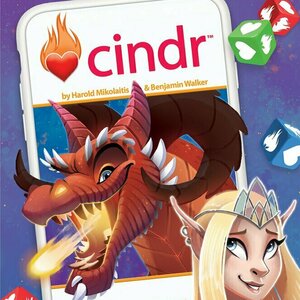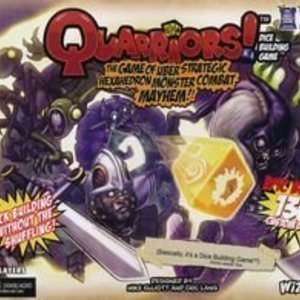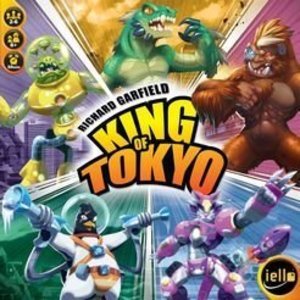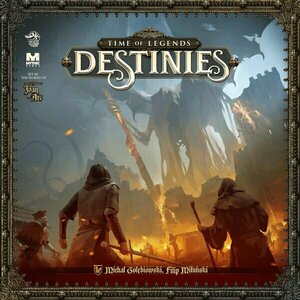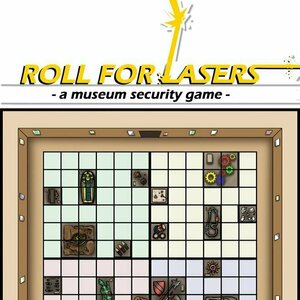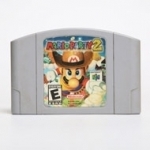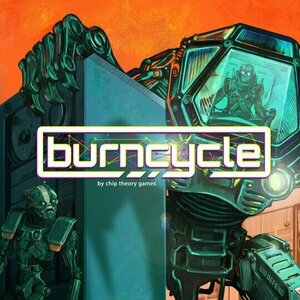Search
Search results
Purple Phoenix Games (2266 KP) rated Cindr in Tabletop Games
Oct 29, 2020
Finally! A game to simulate dating dragons. I have been waiting for this theme all my life and it’s now a reality!! Well, okay, I have never really considered dating a dragon. But I know I would be signing up for a service app like Cindr to find my true dragon mate FO SHO if it were real. So how does a card game dragon sim play?
Cindr has players taking on the persona of a lonely fantasy creature looking for dragon love on a dating app. Players will be building their character by making choices and then swiping left or right to attempt going on dates with dragons that may be a great match. Roll the dice well and things may go to the Next Step, or even the Next Level. Roll poorly and your dear dragon date may send you home aflame.
DISCLAIMER: We were provided a copy of this game for the purposes of this review. This is a retail copy of the game, so what you see in these photos is exactly what would be received in your box. I do not intend to cover every single rule included in the rulebook, but will describe the overall game flow and major rule set so that our readers may get a sense of how the game plays. Furthermore I will be covering the game using the Solo rules (which are no different than the multiplayer rules). For more in depth rules, you may purchase a copy online or from your FLGS. -T
To setup, each player (or just yourself if playing the solo rules as I am) will choose a Character Profile card, filling in the blanks and circling choices to build their new fantasy persona. Each player will take one Try Again card that is useful during game play. Shuffle each Cindr App Dragon Profile and Whelp App Location card deck and place near each other. The dice will be placed near all the cards as well and the game is ready to begin!
On a turn a player will do each of these steps in order: Choose a Dragon to Date, Assemble the Dice Pool, Draw a Location Card, Check Dragon Powers & Location Bonuses, The Date / Roll Dice, Burned by a Dragon, and End of Turn. In the solo game players will be playing long enough to complete five dragon dates.
Choosing a Dragon to Date consists of reading the profile on the top of the deck and deciding whether to date or not. If not, swipe the profile into The Dating Pool below the deck. Players may swipe twice for free, and pay for additional swipes. After a dragon has been chosen, players will Assemble the Dice Pool by flipping the profile card and comparing with the stats they had made for their character at the beginning of the game. For each match players will receive a green die. For each value one space away a blue die, and for two spaces away a red die. Each die color has a different value of faces, but all have hearts and fires. Next the player(s) will Draw a Location Card from the top of the deck, read the front, then flip to the back. The back of the card will list any die up/downgrades and bonuses that may activate at different times during the date. Checking Dragon Powers & Location Bonuses will happen next and are self-explanatory.
Now that a dragon date has been procured and a location chosen, The Date may occur! When on the date, players will roll the four dice up to three times. The first time they are rolled is considered the Meet Up. The Next Step and The Next Level are the second and third rolls respectively. To be considered a full date, players will need to at least roll a second time. It is during The Date that players will be collecting hearts and trying to avoid fires. Three fires and the hearts are lost and the turn over. Players may stop rolling any time they wish and bank the hearts they have won to that point. The hearts then transfer to Love Points that are tracked at the bottom of the Character Profile card.
Should a player roll three flames and have no way to mitigate them, they lose all earned hearts for that round and their turn is over. They were, after all, Burned by a Dragon. The End of Turn is a cleanup phase to setup for the next player (or next round if playing solo). Play continues in this fashion until a player reaches 21+ Love Points in a multiplayer game or after the solo player has gone on five complete dates. Total the points to see who is the winner, or compare against the Love Meter card to see where you stack up.
Components. I’m just going to come out and say it now: I love everything about the components in this game. The dice are excellent and feature GOOD colors (not just boring primary colors). The app cards look like a phone’s screen and that’s brilliant. The Location cards are using a review service named Whelp, and also a stroke of brilliance. The art is amazing, save for the somewhat boring Second Chance cards, and one of the fonts is the same as my favorite game of all time – Valeria: Card Kingdoms, so I am fan for sure.
It’s no use hiding the fact that I am giddy playing this game. Even solo! Yes, I missed out on being able to date dragons from other players’ Dating Pools, but I have access to all the dragons anyway! Being able to adjust your choices during the game as a result of dragon powers or location powers is a neat twist that I wasn’t expecting. Those powers and bonuses are great and can really change the game, and contribute to an already large replayability score from me. It’s just a superb game that I love more and more every time I play it.
Cindr will probably never make my Top 10 Games of All Time, but it will most certainly remain in my Top 100 for years. Again, I wish I had not missed out on the Kickstarter for this one as I am gluttonous for KS stretch goal extras, but I am quite happy with where this game is at retail level. If you are looking for a great game with a hilarious and wonderful theme, plays quickly, and is excellent as a solo game too, then check out Cindr. You will never look at dragon dating sites the same way again. I promise.
Cindr has players taking on the persona of a lonely fantasy creature looking for dragon love on a dating app. Players will be building their character by making choices and then swiping left or right to attempt going on dates with dragons that may be a great match. Roll the dice well and things may go to the Next Step, or even the Next Level. Roll poorly and your dear dragon date may send you home aflame.
DISCLAIMER: We were provided a copy of this game for the purposes of this review. This is a retail copy of the game, so what you see in these photos is exactly what would be received in your box. I do not intend to cover every single rule included in the rulebook, but will describe the overall game flow and major rule set so that our readers may get a sense of how the game plays. Furthermore I will be covering the game using the Solo rules (which are no different than the multiplayer rules). For more in depth rules, you may purchase a copy online or from your FLGS. -T
To setup, each player (or just yourself if playing the solo rules as I am) will choose a Character Profile card, filling in the blanks and circling choices to build their new fantasy persona. Each player will take one Try Again card that is useful during game play. Shuffle each Cindr App Dragon Profile and Whelp App Location card deck and place near each other. The dice will be placed near all the cards as well and the game is ready to begin!
On a turn a player will do each of these steps in order: Choose a Dragon to Date, Assemble the Dice Pool, Draw a Location Card, Check Dragon Powers & Location Bonuses, The Date / Roll Dice, Burned by a Dragon, and End of Turn. In the solo game players will be playing long enough to complete five dragon dates.
Choosing a Dragon to Date consists of reading the profile on the top of the deck and deciding whether to date or not. If not, swipe the profile into The Dating Pool below the deck. Players may swipe twice for free, and pay for additional swipes. After a dragon has been chosen, players will Assemble the Dice Pool by flipping the profile card and comparing with the stats they had made for their character at the beginning of the game. For each match players will receive a green die. For each value one space away a blue die, and for two spaces away a red die. Each die color has a different value of faces, but all have hearts and fires. Next the player(s) will Draw a Location Card from the top of the deck, read the front, then flip to the back. The back of the card will list any die up/downgrades and bonuses that may activate at different times during the date. Checking Dragon Powers & Location Bonuses will happen next and are self-explanatory.
Now that a dragon date has been procured and a location chosen, The Date may occur! When on the date, players will roll the four dice up to three times. The first time they are rolled is considered the Meet Up. The Next Step and The Next Level are the second and third rolls respectively. To be considered a full date, players will need to at least roll a second time. It is during The Date that players will be collecting hearts and trying to avoid fires. Three fires and the hearts are lost and the turn over. Players may stop rolling any time they wish and bank the hearts they have won to that point. The hearts then transfer to Love Points that are tracked at the bottom of the Character Profile card.
Should a player roll three flames and have no way to mitigate them, they lose all earned hearts for that round and their turn is over. They were, after all, Burned by a Dragon. The End of Turn is a cleanup phase to setup for the next player (or next round if playing solo). Play continues in this fashion until a player reaches 21+ Love Points in a multiplayer game or after the solo player has gone on five complete dates. Total the points to see who is the winner, or compare against the Love Meter card to see where you stack up.
Components. I’m just going to come out and say it now: I love everything about the components in this game. The dice are excellent and feature GOOD colors (not just boring primary colors). The app cards look like a phone’s screen and that’s brilliant. The Location cards are using a review service named Whelp, and also a stroke of brilliance. The art is amazing, save for the somewhat boring Second Chance cards, and one of the fonts is the same as my favorite game of all time – Valeria: Card Kingdoms, so I am fan for sure.
It’s no use hiding the fact that I am giddy playing this game. Even solo! Yes, I missed out on being able to date dragons from other players’ Dating Pools, but I have access to all the dragons anyway! Being able to adjust your choices during the game as a result of dragon powers or location powers is a neat twist that I wasn’t expecting. Those powers and bonuses are great and can really change the game, and contribute to an already large replayability score from me. It’s just a superb game that I love more and more every time I play it.
Cindr will probably never make my Top 10 Games of All Time, but it will most certainly remain in my Top 100 for years. Again, I wish I had not missed out on the Kickstarter for this one as I am gluttonous for KS stretch goal extras, but I am quite happy with where this game is at retail level. If you are looking for a great game with a hilarious and wonderful theme, plays quickly, and is excellent as a solo game too, then check out Cindr. You will never look at dragon dating sites the same way again. I promise.
Purple Phoenix Games (2266 KP) rated Dicetopia in Tabletop Games
Jun 12, 2019
As board gamers, we are always looking for cool new games to play! Occasionally, that search takes us to Kickstarter, which is where I found Dicetopia. After reading the campaign page, I was immediately hooked and decided to back it! I enjoyed following Dicetopia through production, and the finished product is everything I hoped it would be! Maybe after reading this review, you’ll want to give it a try too!
Welcome to the Dicetopia – a vast city teeming with opportunity. Some people capitalize on those opportunities for the greater good, but not you. You and your faction have more dubious motivations – you see a city ripe for the taking. Unfortunately for you, other factions in the city see the same thing. Now, you must work quickly and quietly to gain control over the city’s neighborhoods before your opponents! Pick up loot, carry out secret missions, and undermine your opponent in any way possible. The sneakiest and most clever faction will come out on top – will it be yours?
In Dicetopia, you are a member of a faction vying for control of the city. You and your opponents have secret missions to complete, and your strategy will vary depending on those missions. On your turn, you will swap one of the agents from your faction board with a die from any neighborhood. Each neighborhood has an action associated with it, and placing an agent there allows you to take the designated action. Neighborhood actions could be beneficial for you (re-rolling a die on your faction board), or they could be detrimental for your opponent (swapping one of their dice for one from the board). A controlling presence is one key to success, so make sure you have more agents than your opponent in any neighborhood! End-game scoring is in three parts: 1. Die total from your faction board, 2. Points for controlling a neighborhood, and 3. Successful completion of your secret missions. The player with the highest score wins!
Overall, I love Dicetopia. It’s kind of a game of worker placement without the weight that is sometimes associated with that mechanic. As someone who has not played many worker placement games before, I think Dicetopia does a good job introducing players to the mechanic. You place your agent, take the die, perform the corresponding action, and that’s your turn. Easy peasy. And since your secret missions dictate your strategy, the game is really more about dice/set collection than it is about worker placement. Another thing I like about the game is that it is dictated by dice, which means you’ll never play the same game twice. All of the dice are rolled and randomly placed during setup, so your city board will always be different for each game. And depending on your secret missions, the die values could make completing your secret missions easier or harder! That means you have to strategize your use of neighborhood actions even more! There is so much more strategy involved in this game than meets the eye, and I love that.
The one thing I do not like about Dicetopia is that whenever you place an agent in a neighborhood, you must take the corresponding action. Even if you don’t want to, or if it would be against your best interest. That gets a little frustrating as the game goes on, because some actions (later in the game) could essentially undo your entire game, costing you points by altering your success on secret missions. I wish the neighborhood actions were optional, because then it wouldn’t feel like my entire game strategy had been thrown out the window in the last couple of turns.
Besides my one grievance with the neighborhood actions, I really thoroughly enjoy playing Dicetopia. It was definitely a great find on Kickstarter for me, and I hope you’ll decide to give it a shot too! Purple Phoenix Games gives it a 9 / 12.
https://purplephoenixgames.wordpress.com/2018/12/17/dicetopia-review/
Welcome to the Dicetopia – a vast city teeming with opportunity. Some people capitalize on those opportunities for the greater good, but not you. You and your faction have more dubious motivations – you see a city ripe for the taking. Unfortunately for you, other factions in the city see the same thing. Now, you must work quickly and quietly to gain control over the city’s neighborhoods before your opponents! Pick up loot, carry out secret missions, and undermine your opponent in any way possible. The sneakiest and most clever faction will come out on top – will it be yours?
In Dicetopia, you are a member of a faction vying for control of the city. You and your opponents have secret missions to complete, and your strategy will vary depending on those missions. On your turn, you will swap one of the agents from your faction board with a die from any neighborhood. Each neighborhood has an action associated with it, and placing an agent there allows you to take the designated action. Neighborhood actions could be beneficial for you (re-rolling a die on your faction board), or they could be detrimental for your opponent (swapping one of their dice for one from the board). A controlling presence is one key to success, so make sure you have more agents than your opponent in any neighborhood! End-game scoring is in three parts: 1. Die total from your faction board, 2. Points for controlling a neighborhood, and 3. Successful completion of your secret missions. The player with the highest score wins!
Overall, I love Dicetopia. It’s kind of a game of worker placement without the weight that is sometimes associated with that mechanic. As someone who has not played many worker placement games before, I think Dicetopia does a good job introducing players to the mechanic. You place your agent, take the die, perform the corresponding action, and that’s your turn. Easy peasy. And since your secret missions dictate your strategy, the game is really more about dice/set collection than it is about worker placement. Another thing I like about the game is that it is dictated by dice, which means you’ll never play the same game twice. All of the dice are rolled and randomly placed during setup, so your city board will always be different for each game. And depending on your secret missions, the die values could make completing your secret missions easier or harder! That means you have to strategize your use of neighborhood actions even more! There is so much more strategy involved in this game than meets the eye, and I love that.
The one thing I do not like about Dicetopia is that whenever you place an agent in a neighborhood, you must take the corresponding action. Even if you don’t want to, or if it would be against your best interest. That gets a little frustrating as the game goes on, because some actions (later in the game) could essentially undo your entire game, costing you points by altering your success on secret missions. I wish the neighborhood actions were optional, because then it wouldn’t feel like my entire game strategy had been thrown out the window in the last couple of turns.
Besides my one grievance with the neighborhood actions, I really thoroughly enjoy playing Dicetopia. It was definitely a great find on Kickstarter for me, and I hope you’ll decide to give it a shot too! Purple Phoenix Games gives it a 9 / 12.
https://purplephoenixgames.wordpress.com/2018/12/17/dicetopia-review/
Lumos (380 KP) rated Quarriors! in Tabletop Games
Mar 19, 2018
A unique spin on the "deck builder". I like that instead of building a deck of cards, you are building a bag of dice. Each die has a different "spell" with a different power depending on how you roll. The game has the potential to be different every time you play, depending on the expansions you have. The fighting mechanic is well done and easy to maneuver. I would suggest using the "mat" included on the back of the instructions as sometimes it is hard to remember what has been spent and what is locked or on deck.
If you like to have complete sets of games and own all the expansions (like my friends and I do), it's good to know that the Light and Dark expansion doesn't really play well when mixed with the rest of the game. It does work as a stand alone though.
If you like to have complete sets of games and own all the expansions (like my friends and I do), it's good to know that the Light and Dark expansion doesn't really play well when mixed with the rest of the game. It does work as a stand alone though.
Ben (262 KP) rated King of Tokyo in Tabletop Games
Aug 4, 2019
Short-medium length (3 more)
Skill/Luck Combo
Different strategies can win
Excellent theme
This is a game I consistently come back to as a lightweight game to spice up a hohum evening. I love the theme of this game and how the cards that you are able to buy play so well into the theme and add tremendous amounts of replayability to it. The mechanics in the game are super simple and I have no problem brining it to the table for gamers and non-gamers alike. Pertaining to it's wide assessibility, this game scales so well for all of its player counts. I've even been able to play a four monster game with 2 and 3 people. Lastly, this game was one of my first Yahtzee style, dice manipulation games, but due to my fiance and my enjoyment of the game, we've been excited to try more with the same mechanism.
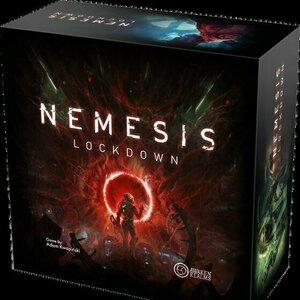
Nemesis Lockdown
Tabletop Game
Nemesis Lockdown is first stand alone expansion to Nemesis. During the game, players will be taken...
Purple Phoenix Games (2266 KP) rated Destinies in Tabletop Games
Jan 29, 2022
I can recall so many instances of my board game purchases being based on either the designer, artist, or publisher. Surely I am not alone here. Josh will probably always be a Stonemaier Games fanboy. Laura has aligned herself with Daily Magic Games and Button Shy Games. While I am a big fan of the Valeriaverse, I think my current preferences put me on teams Weird Giraffe Games, Blue Orange Games, and Lucky Duck Games. Speaking of the latter, LDG have come through with some seriously excellent hybrid app-driven games that just wow me every single time. I was definitely a hybrid game naysayer when the first Chronicles of Crime came out, but the more I play them, the more I appreciate the accomplishments. Destinies has now come along to me and it has been some time since I have been this jazzed to play a game over and over and over and over.
Destinies is a hybrid app-driven adventure board game for one to three players. In it, players will be choosing their characters and how to play them, along with the path of their individual destinies across several campaign scenarios. When playing multiplayer, the player who completes their destiny first will win. When playing solo (which is also amazing), the player wins when they successfully complete their destiny.
DISCLAIMER: We are using the Kickstarter version of the game. We do have the expansions from the KS campaign, but will not be using those for this review. Also, we do not intend to cover every single rule included in the rule book, but will describe the overall game flow and major rule set so that our readers may get a sense of how the game plays. For more in depth rules, you may purchase a copy from the publisher directly or from your FLGS. -T
Usually I list out the steps to setup a game in this section, but there are so many little items and steps to be taken that I will simply show you, the reader, how a scenario may look once setup. The app will instruct players how to create their character’s stats and which map tiles should be placed out initially. Typically, though, each player will receive a player board, Destiny card (with their character headshot on one side and their Destiny choices on back), two main dice, three effort dice, and one gold coin. Once setup, the app will drive the story along and the players will be rolling dice and making choices in order to win the game or scenario.
Each player will be given their Destiny card with two distinct Destiny paths on the backside. These paths correlate with the current scenario, and the player will be able to choose one of the two given paths to help move their games forward. However, sometimes players will switch their Destiny mid-game due to several factors including successes on previous tasks or current inventory. The only way to win the game is to complete a Destiny, so staying on track is paramount in this open sandbox game – it is incredibly easy to become sidetracked and lose sight of specific tasks to be performed.
Each turn a player may move to a new tile, to previously-explored tiles, or points of interest on specific map tiles. These points of interest could be unique characters to be visited, or more general spaces on the tile represented by tokens. Sometimes visiting a POI (point of interest) will have the player rolling dice to complete tests, initiating trade with the POI NPC, revealing information about their distinct Destiny, or even issuing side quests. Players take their chances by visiting a POI because only one may be visited on a turn. Once a player has moved and visited a POI, their turn is over and the next player’s turn begins.
The most interesting aspect of this game is the experience tracker and results of tests. Player stats are divided between Intelligence, Dexterity, and Power (Strength for my D&D readers). These stats are constantly in flux due to tests and experience, and levels range from 1-12+ on the player board. A player will roll both main dice and any effort dice they wish on each test, and the total result is compared to the discs present on the main player board. One success is counted for each disc’s value equal to or below the rolled result. For example, if the roll is a 6, and the player has a disc on 3 and another on 6 the player counts two successes. Effort dice add values to the rolled result, and one side of these dice depict a star, which counts as one success. Throughout the game players will be moving their skill marker tokens (discs) up and down the tracks. Sometimes this is due to a test being failed or succeeded, but sometimes experience tokens are earned. A player may improve their skill levels by two total values on the tracks for each experience token discarded. Players may choose which tracks, and may maximize their character’s skill or spread out the experience across multiple skills.
Play continues in this fashion of referencing the app for story and plot items, players working toward completing their Destinies, and adventuring across the land rolling tests and improving skills until one player finishes their Destiny and wins the game!
Components. As always, I am going to be honest here by stating I believe that Destinies packs the box with the best components I have seen in a game. The multi-layered insert is perfectly formed and well-thought out, all the cardboard tokens are super-thick, the dice are so fun to handle and roll, the cards and other components feature incredible artwork, and did I mention there’s about a thousand minis in this game? I am reluctant to even call some of these things minis as they are large and in charge for SURE. I have zero complaints or comments on the components present in Destinies. Lucky Duck knocks it out of the park once again. Incredible.
I actually backed this one on Kickstarter just because it comes from Lucky Duck Games. I had played Chronicles of Crime and loved it, and just wanted to try something different but using a similar system. Typically I don’t keep up with the comments and updates to a game I have backed because I enjoy being surprised by the product that arrives at my door. Destinies was certainly a surprise to me, and I have been kicking myself in the butt for not getting it to the table the very first day I received it.
Destinies is my favorite Lucky Duck Games title, and that is saying a ton, as I rave about every game of theirs I have played. I hope you all back me up here, and if you haven’t yet tried this one, I hope you visit your closest friend or board game cafe that owns it. The tutorial scenario is great, and the campaign scenarios have been awesome so far. Okay, yes, when I first played it with Laura, my wife made several comments about it being a 3 hour game, but once that first one is completed, the subsequent plays run much smoother.
What I love so much about this is how indefinitely expandable it is. Most of the components are multi-use (akin to all the character cards in the Chronicles of Crime games), and can be used in campaign after campaign. The drawbacks I see for this, though, is any sort of waning interest in it forcing designers to abandon plans to create more scenarios. Could a new scenario pack be an acceptable expansion versus a large expansion box with oodles of new components and minis? I think so, but I am no designer. Could the Millennium Series treatment be given to Destinies? Absolutely! This system does not need to be played in a medieval fantasy world. It could be molded to almost anything, and that gives me excited shivers over the future of this game.
If you are anything like me and have now embraced the hybrid gaming trend, I highly recommend Destinies. I plan to also review all the expansions in the near future, so do look out for those, but please do yourself a giant favor and pick up Destinies. The excellent storytelling, great components, and just amazing fun helps Purple Phoenix Games give this one a perfectly deserved 12 / 12, and a Golden Feather Award! I can’t stop thinking about it and how I would play it differently next time, and hopefully after I have played through the expansion material I will be able to restart from the very beginning with different characters and choices. It’s a sign of a great game when I can’t stop thinking about it, and I do believe Destinies currently is knocking at the door of my Top 10 Games of All Time. No, it’s there. It’s totally there. TOP 10 BABY!!
Destinies is a hybrid app-driven adventure board game for one to three players. In it, players will be choosing their characters and how to play them, along with the path of their individual destinies across several campaign scenarios. When playing multiplayer, the player who completes their destiny first will win. When playing solo (which is also amazing), the player wins when they successfully complete their destiny.
DISCLAIMER: We are using the Kickstarter version of the game. We do have the expansions from the KS campaign, but will not be using those for this review. Also, we do not intend to cover every single rule included in the rule book, but will describe the overall game flow and major rule set so that our readers may get a sense of how the game plays. For more in depth rules, you may purchase a copy from the publisher directly or from your FLGS. -T
Usually I list out the steps to setup a game in this section, but there are so many little items and steps to be taken that I will simply show you, the reader, how a scenario may look once setup. The app will instruct players how to create their character’s stats and which map tiles should be placed out initially. Typically, though, each player will receive a player board, Destiny card (with their character headshot on one side and their Destiny choices on back), two main dice, three effort dice, and one gold coin. Once setup, the app will drive the story along and the players will be rolling dice and making choices in order to win the game or scenario.
Each player will be given their Destiny card with two distinct Destiny paths on the backside. These paths correlate with the current scenario, and the player will be able to choose one of the two given paths to help move their games forward. However, sometimes players will switch their Destiny mid-game due to several factors including successes on previous tasks or current inventory. The only way to win the game is to complete a Destiny, so staying on track is paramount in this open sandbox game – it is incredibly easy to become sidetracked and lose sight of specific tasks to be performed.
Each turn a player may move to a new tile, to previously-explored tiles, or points of interest on specific map tiles. These points of interest could be unique characters to be visited, or more general spaces on the tile represented by tokens. Sometimes visiting a POI (point of interest) will have the player rolling dice to complete tests, initiating trade with the POI NPC, revealing information about their distinct Destiny, or even issuing side quests. Players take their chances by visiting a POI because only one may be visited on a turn. Once a player has moved and visited a POI, their turn is over and the next player’s turn begins.
The most interesting aspect of this game is the experience tracker and results of tests. Player stats are divided between Intelligence, Dexterity, and Power (Strength for my D&D readers). These stats are constantly in flux due to tests and experience, and levels range from 1-12+ on the player board. A player will roll both main dice and any effort dice they wish on each test, and the total result is compared to the discs present on the main player board. One success is counted for each disc’s value equal to or below the rolled result. For example, if the roll is a 6, and the player has a disc on 3 and another on 6 the player counts two successes. Effort dice add values to the rolled result, and one side of these dice depict a star, which counts as one success. Throughout the game players will be moving their skill marker tokens (discs) up and down the tracks. Sometimes this is due to a test being failed or succeeded, but sometimes experience tokens are earned. A player may improve their skill levels by two total values on the tracks for each experience token discarded. Players may choose which tracks, and may maximize their character’s skill or spread out the experience across multiple skills.
Play continues in this fashion of referencing the app for story and plot items, players working toward completing their Destinies, and adventuring across the land rolling tests and improving skills until one player finishes their Destiny and wins the game!
Components. As always, I am going to be honest here by stating I believe that Destinies packs the box with the best components I have seen in a game. The multi-layered insert is perfectly formed and well-thought out, all the cardboard tokens are super-thick, the dice are so fun to handle and roll, the cards and other components feature incredible artwork, and did I mention there’s about a thousand minis in this game? I am reluctant to even call some of these things minis as they are large and in charge for SURE. I have zero complaints or comments on the components present in Destinies. Lucky Duck knocks it out of the park once again. Incredible.
I actually backed this one on Kickstarter just because it comes from Lucky Duck Games. I had played Chronicles of Crime and loved it, and just wanted to try something different but using a similar system. Typically I don’t keep up with the comments and updates to a game I have backed because I enjoy being surprised by the product that arrives at my door. Destinies was certainly a surprise to me, and I have been kicking myself in the butt for not getting it to the table the very first day I received it.
Destinies is my favorite Lucky Duck Games title, and that is saying a ton, as I rave about every game of theirs I have played. I hope you all back me up here, and if you haven’t yet tried this one, I hope you visit your closest friend or board game cafe that owns it. The tutorial scenario is great, and the campaign scenarios have been awesome so far. Okay, yes, when I first played it with Laura, my wife made several comments about it being a 3 hour game, but once that first one is completed, the subsequent plays run much smoother.
What I love so much about this is how indefinitely expandable it is. Most of the components are multi-use (akin to all the character cards in the Chronicles of Crime games), and can be used in campaign after campaign. The drawbacks I see for this, though, is any sort of waning interest in it forcing designers to abandon plans to create more scenarios. Could a new scenario pack be an acceptable expansion versus a large expansion box with oodles of new components and minis? I think so, but I am no designer. Could the Millennium Series treatment be given to Destinies? Absolutely! This system does not need to be played in a medieval fantasy world. It could be molded to almost anything, and that gives me excited shivers over the future of this game.
If you are anything like me and have now embraced the hybrid gaming trend, I highly recommend Destinies. I plan to also review all the expansions in the near future, so do look out for those, but please do yourself a giant favor and pick up Destinies. The excellent storytelling, great components, and just amazing fun helps Purple Phoenix Games give this one a perfectly deserved 12 / 12, and a Golden Feather Award! I can’t stop thinking about it and how I would play it differently next time, and hopefully after I have played through the expansion material I will be able to restart from the very beginning with different characters and choices. It’s a sign of a great game when I can’t stop thinking about it, and I do believe Destinies currently is knocking at the door of my Top 10 Games of All Time. No, it’s there. It’s totally there. TOP 10 BABY!!
Purple Phoenix Games (2266 KP) rated Roll for Lasers in Tabletop Games
Aug 3, 2020
Frickin’ lasers?! You made a game about frickin’ lasers? Yop. Well, WE didn’t, but Glass Shoe Games did. You’re a museum security company vying for the museum’s contract against other companies. The contract will go to the company who can arrange security lasers and mirrors in the most strategic locations to keep the museum’s collection safe. But also you will need to utilize the previous company’s placed mirrors and targets.
Roll for Lasers is a one-page roll and write game where the winner is the player whose company can hit placed targets more often (Victory Points) with lasers. Targets and mirrors will be placed all over the museum floor, so utilizing proper strategy, well-timed re-rolls, and special actions will see the winner awarded the security contract.
DISCLAIMER: We were provided a prototype copy of this game for the purposes of this review. These are preview copy components. Also, it is not my intention to detail every rule in the game, but to give our readers a general feel for how the game plays. You can back the game through the Kickstarter campaign launching August 4, 2020, order from your FLGS, or purchase through any retailers stocking it after fulfillment. -T
Setup for Roll for Lasers is simple. Give every player a pen (or erasable marker for laminated sheets) and 6d6. Decide as a group which three special actions to use for the game and you are ready to begin!
NOTE: Though I appreciate the USPS for everything they do, check out the picture below. I mean, come on. It didn’t hinder our play at all, but sheesh.
Play will commence in rounds. Each round will have three phases. The first phase is rolling for targets. Using the prescribed starting corner, players will roll all 6d6 and use these results to create x- and y-axis pairs to plot up to three targets in their mini grid. These are depicted by circles. The next phase is placing mirrors, and the players will again roll all 6d6 to be used to place up to three mirrors, depicted by diagonal lines. Finally, players will again roll all 6d6 to find either three singular dice or combinations of dice to fire a laser from the side or bottom of their grid in a straight line. For all targets the laser passes through, count 1VP. Each mirror encountered will alter the pathway of the laser, and by the end of the game lasers will be bouncing all over the museum. Play continues for three or four rounds (depending on player count) and once the last round ends, players count up VP to determine the winner!
Components. Again, we were provided a prototype copy of the game for this preview, and at this point I do not know what, if anything, will be changing as a result of a successful Kickstarter campaign. However, we were provided a nicely laminated sheet and a dry-erase marker to use. The sheet is laid out well, and the art is interesting without being in the way at all. Since Glass Shoe Games sent us an orange dry-erase marker (GREAT color choice btw) I borrowed the 6d6 from Roll Player because I knew I would find about a thousand d6 in that box. So components are minimal, and that’s quite all right with us this time.
Roll and write games are still popular now, and I, for one, am quite excited for that to be the case. I love being able to pull out a few dice, explain a few rules, and then get to playing. Roll for Lasers certainly delivers when I feel I have about 5-10 minutes to play something but still want a thinky experience. Rolling the dice and then determining which pair or combination of dice to use can get a little burdensome with AP-prone players, but being able to place the perfect mirror to foil an opponent, or adeptly using one of the special actions (like the triple-point target) is very rewarding. What I have also found with this is that all players are in the game until the very end. As you will see below, in my play against my wife I was behind for the first three rounds, but that last round was super robust for me and I finished way further ahead.
I love games that can be fun without having tons of components (I love games with tons of components too, don’t get me wrong), and Roll for Lasers is a great example of this. I have had a great time playing this every time, and can certainly see myself pulling this out a lot once game nights can safely return to normal. If you are missing a fast minimal roll and write for your collection with an interesting theme, consider backing or ordering Roll for Lasers.
Roll for Lasers is a one-page roll and write game where the winner is the player whose company can hit placed targets more often (Victory Points) with lasers. Targets and mirrors will be placed all over the museum floor, so utilizing proper strategy, well-timed re-rolls, and special actions will see the winner awarded the security contract.
DISCLAIMER: We were provided a prototype copy of this game for the purposes of this review. These are preview copy components. Also, it is not my intention to detail every rule in the game, but to give our readers a general feel for how the game plays. You can back the game through the Kickstarter campaign launching August 4, 2020, order from your FLGS, or purchase through any retailers stocking it after fulfillment. -T
Setup for Roll for Lasers is simple. Give every player a pen (or erasable marker for laminated sheets) and 6d6. Decide as a group which three special actions to use for the game and you are ready to begin!
NOTE: Though I appreciate the USPS for everything they do, check out the picture below. I mean, come on. It didn’t hinder our play at all, but sheesh.
Play will commence in rounds. Each round will have three phases. The first phase is rolling for targets. Using the prescribed starting corner, players will roll all 6d6 and use these results to create x- and y-axis pairs to plot up to three targets in their mini grid. These are depicted by circles. The next phase is placing mirrors, and the players will again roll all 6d6 to be used to place up to three mirrors, depicted by diagonal lines. Finally, players will again roll all 6d6 to find either three singular dice or combinations of dice to fire a laser from the side or bottom of their grid in a straight line. For all targets the laser passes through, count 1VP. Each mirror encountered will alter the pathway of the laser, and by the end of the game lasers will be bouncing all over the museum. Play continues for three or four rounds (depending on player count) and once the last round ends, players count up VP to determine the winner!
Components. Again, we were provided a prototype copy of the game for this preview, and at this point I do not know what, if anything, will be changing as a result of a successful Kickstarter campaign. However, we were provided a nicely laminated sheet and a dry-erase marker to use. The sheet is laid out well, and the art is interesting without being in the way at all. Since Glass Shoe Games sent us an orange dry-erase marker (GREAT color choice btw) I borrowed the 6d6 from Roll Player because I knew I would find about a thousand d6 in that box. So components are minimal, and that’s quite all right with us this time.
Roll and write games are still popular now, and I, for one, am quite excited for that to be the case. I love being able to pull out a few dice, explain a few rules, and then get to playing. Roll for Lasers certainly delivers when I feel I have about 5-10 minutes to play something but still want a thinky experience. Rolling the dice and then determining which pair or combination of dice to use can get a little burdensome with AP-prone players, but being able to place the perfect mirror to foil an opponent, or adeptly using one of the special actions (like the triple-point target) is very rewarding. What I have also found with this is that all players are in the game until the very end. As you will see below, in my play against my wife I was behind for the first three rounds, but that last round was super robust for me and I finished way further ahead.
I love games that can be fun without having tons of components (I love games with tons of components too, don’t get me wrong), and Roll for Lasers is a great example of this. I have had a great time playing this every time, and can certainly see myself pulling this out a lot once game nights can safely return to normal. If you are missing a fast minimal roll and write for your collection with an interesting theme, consider backing or ordering Roll for Lasers.
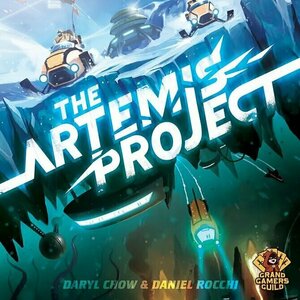
The Artemis Project
Tabletop Game
Europa, Jupiter's moon. Deep beneath the crust, the oceans are teeming with alien sea life....
Matthew Krueger (10051 KP) rated Mario Party 2 in Video Games
Dec 23, 2020
Let The Party Continue
Mario 2- is the sequel to Mario Party in the Mario Party franchise. That came out a year later on the N64. New boards, new minigames, same charcters, just with the number 2 on it.
In the game's storyline, Mario and his friends create a world built from their dreams and get into a debate over who the new world would be named after. When Bowser arrives and invades the land, the group takes Toad's suggestion to name it after the "Super Star" who defeats Bowser.
Mario Party 2 includes multiplayer compatibility; each game on a board map consists of four players, including at least one human player and up to four. Any character who is not controlled by a human will instead be controlled by the game as a computer-controlled character.
The goal of Mario Party 2 is to collect the most Stars within the allotted amount of turns. Stars must be purchased from Toad with coins, which can be earned through a selection from one of 64 mini-games that is played once at the end of each turn.
The players can obtain items for use on the board, and can each carry one at a time. If a player is carrying an item, they can use it before rolling the dice block. Items can aid the player in such ways as providing additional dice blocks or stealing another player's item. One item, the Skeleton Key, allows the player to use shortcuts located on each board map.
During the final five turns of a game, a one-on-one Duel mini-game is initiated when a player lands on the same space as another.
Its Mario Party but better. Why did nintendo not bring back the costumes. Only in this one, you see Mario dress up as a pirate. Come on Nintendo, Mario Party uhhh i lost count, better have it.
I like this one better than One. One is still good, but i fell this one is better.
In the game's storyline, Mario and his friends create a world built from their dreams and get into a debate over who the new world would be named after. When Bowser arrives and invades the land, the group takes Toad's suggestion to name it after the "Super Star" who defeats Bowser.
Mario Party 2 includes multiplayer compatibility; each game on a board map consists of four players, including at least one human player and up to four. Any character who is not controlled by a human will instead be controlled by the game as a computer-controlled character.
The goal of Mario Party 2 is to collect the most Stars within the allotted amount of turns. Stars must be purchased from Toad with coins, which can be earned through a selection from one of 64 mini-games that is played once at the end of each turn.
The players can obtain items for use on the board, and can each carry one at a time. If a player is carrying an item, they can use it before rolling the dice block. Items can aid the player in such ways as providing additional dice blocks or stealing another player's item. One item, the Skeleton Key, allows the player to use shortcuts located on each board map.
During the final five turns of a game, a one-on-one Duel mini-game is initiated when a player lands on the same space as another.
Its Mario Party but better. Why did nintendo not bring back the costumes. Only in this one, you see Mario dress up as a pirate. Come on Nintendo, Mario Party uhhh i lost count, better have it.
I like this one better than One. One is still good, but i fell this one is better.
